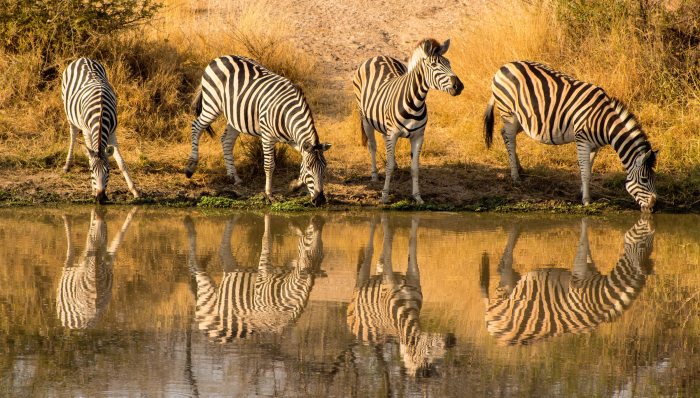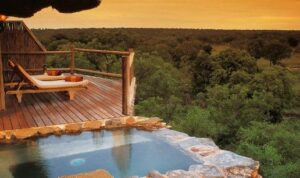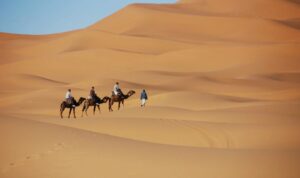Africa Wildlife Conservation is a critical endeavor that safeguards not only a rich tapestry of biodiversity but also the very fabric of the continent’s ecological balance. From the majestic elephants roaming the savannas to the vibrant coral reefs teeming with life, Africa’s wildlife plays a vital role in maintaining healthy ecosystems, supporting local communities, and driving sustainable tourism.
The continent’s diverse wildlife is a source of cultural and economic value, contributing to the livelihoods of millions through tourism, traditional medicine, and cultural practices. However, this invaluable resource faces numerous threats, including habitat loss, poaching, human-wildlife conflict, and the ever-present threat of climate change.
The Importance of African Wildlife Conservation

Africa is home to a vast array of wildlife, encompassing a diverse range of species that play crucial roles in maintaining the delicate balance of ecosystems across the continent. The conservation of this remarkable biodiversity is not only essential for the health of the natural world but also for the well-being of human communities and the sustainable development of the African continent.
Ecological Significance of African Wildlife
African wildlife is integral to the functioning of ecosystems across the continent. Predators like lions, leopards, and cheetahs regulate prey populations, preventing overgrazing and maintaining the health of plant communities. Herbivores like elephants, zebras, and wildebeest play a vital role in shaping landscapes through their grazing and browsing habits. These activities contribute to the dispersal of seeds, nutrient cycling, and the creation of habitats for other species. For instance, elephants are known to create clearings in forests, providing space for other species to thrive. The interconnectedness of species within African ecosystems highlights the importance of conserving all components of the wildlife community.
Cultural and Economic Value of African Wildlife, Africa Wildlife Conservation
African wildlife holds profound cultural and economic significance for local communities and the continent as a whole. For centuries, wildlife has been a source of sustenance, cultural inspiration, and spiritual connection for indigenous peoples. The presence of wildlife contributes to the unique identity and cultural heritage of many African communities. For example, the Maasai people of East Africa have a deep spiritual connection to lions, viewing them as symbols of strength and courage.
Beyond cultural significance, African wildlife is a major driver of economic activity, particularly in the tourism sector. The continent’s iconic wildlife, such as elephants, lions, and gorillas, attracts millions of tourists each year, generating revenue for local communities, governments, and businesses. Wildlife tourism creates jobs, supports local economies, and provides incentives for conservation efforts. In countries like Kenya and Tanzania, wildlife tourism accounts for a significant portion of GDP.
Wildlife Conservation and Sustainable Tourism
The development of sustainable tourism practices is crucial for balancing the economic benefits of wildlife tourism with the need for conservation. Sustainable tourism aims to minimize the negative impacts of tourism on wildlife and the environment while maximizing the benefits for local communities. This involves promoting responsible tourism practices, such as minimizing disturbance to wildlife, supporting local businesses, and contributing to conservation efforts. Examples of sustainable tourism initiatives include community-based conservation projects, where local communities are directly involved in managing and benefiting from wildlife tourism. These projects empower local communities, promote responsible tourism, and contribute to the long-term conservation of wildlife.
Threats to African Wildlife

Africa’s diverse wildlife faces numerous threats that jeopardize its survival and the delicate balance of its ecosystems. These threats are interconnected and often exacerbate each other, posing a significant challenge to conservation efforts.
Habitat Loss
Habitat loss is a primary driver of wildlife decline in Africa. The conversion of natural habitats for agriculture, logging, mining, and infrastructure development fragments ecosystems and reduces the space available for wildlife. For example, the expansion of agricultural land in the savannas of East Africa has led to the loss of critical grazing grounds for herbivores like zebras and wildebeest, contributing to population declines.
Poaching
Illegal wildlife poaching for the trade in animal parts, such as ivory, rhino horn, and bushmeat, is a major threat to African wildlife. Poaching has decimated populations of elephants, rhinos, and other iconic species. For instance, the African elephant population has declined by over 60% in the last 50 years due to poaching for ivory.
Human-Wildlife Conflict
As human populations expand and encroach on wildlife habitats, conflicts between humans and wildlife increase. This can result in livestock depredation, crop damage, and human injuries. For example, in areas where elephants roam, farmers often suffer crop damage and livestock losses, leading to retaliatory killings.
Climate Change
Climate change is exacerbating existing threats to African wildlife. Rising temperatures, changes in rainfall patterns, and more frequent droughts are altering ecosystems and affecting wildlife populations. For example, the increasing frequency of droughts in the Sahel region has led to the decline of migratory bird populations, as their breeding grounds are becoming drier and less hospitable.
Conservation Strategies and Initiatives

Africa’s wildlife faces numerous threats, but the continent is also home to a wide range of conservation strategies and initiatives aimed at protecting its biodiversity. These efforts involve a multi-faceted approach that encompasses the establishment of protected areas, fostering community engagement, combating poaching, and promoting sustainable land management practices.
Protected Areas
Protected areas play a crucial role in safeguarding African wildlife by providing safe havens for species and ecosystems. These areas are designated for conservation purposes and are subject to varying levels of protection. They can range from national parks and reserves to community-based conservation areas.
- National Parks and Reserves: These areas are often managed by government agencies and provide strict protection for wildlife. Examples include the Serengeti National Park in Tanzania and Kruger National Park in South Africa.
- Community-Based Conservation Areas: These areas are managed by local communities and often involve partnerships with conservation organizations. This approach empowers local communities to participate in conservation efforts, contributing to the sustainable management of wildlife resources.
Community-Based Conservation
Community-based conservation recognizes the importance of engaging local communities in conservation efforts. By empowering local communities to manage wildlife resources, this approach promotes sustainable livelihoods and reduces conflicts between humans and wildlife.
- Community Wildlife Management Areas (CWMAs): CWMAs are areas managed by local communities, often with support from government agencies and conservation organizations. These areas allow communities to benefit from wildlife tourism and other sustainable activities, fostering a sense of ownership and responsibility for conservation.
- Community-Based Anti-Poaching Units: Local communities play a crucial role in combating poaching. By forming anti-poaching units, communities can actively participate in protecting wildlife within their territories, reducing the threat of illegal hunting and trade.
Anti-Poaching Efforts
Poaching remains a significant threat to African wildlife, driving the decline of many species. To address this challenge, various anti-poaching efforts are implemented, involving government agencies, conservation organizations, and local communities.
- Increased Patrols and Surveillance: Anti-poaching patrols are essential for deterring poachers and detecting illegal activities. These patrols are often conducted by rangers, park guards, and community members, utilizing various technologies and strategies.
- Community Engagement: Engaging local communities in anti-poaching efforts is crucial. By providing training, incentives, and awareness campaigns, communities can become active partners in protecting wildlife.
- International Cooperation: Combating wildlife trafficking requires international cooperation to disrupt illegal trade networks and strengthen law enforcement efforts. This includes collaboration between countries, organizations, and agencies.
Sustainable Land Management Practices
Sustainable land management practices are essential for maintaining the health and resilience of African ecosystems. These practices aim to balance human needs with the conservation of biodiversity.
- Reducing Deforestation: Deforestation is a major threat to wildlife habitats. Sustainable land management practices aim to reduce deforestation by promoting sustainable forestry practices, reforestation, and alternative livelihoods.
- Promoting Agroforestry: Agroforestry combines agriculture with forestry, integrating trees into farming systems. This approach can enhance biodiversity, improve soil fertility, and provide additional income opportunities for farmers.
- Sustainable Agriculture: Sustainable agricultural practices, such as organic farming and conservation tillage, can minimize the negative impacts of agriculture on wildlife habitats.
Role of International Organizations and Governments
International organizations and governments play a vital role in supporting wildlife conservation in Africa. They provide funding, technical expertise, and policy frameworks to guide conservation efforts.
- International Organizations: Organizations like the World Wide Fund for Nature (WWF), Wildlife Conservation Society (WCS), and the International Union for Conservation of Nature (IUCN) play a crucial role in supporting conservation initiatives, providing funding, expertise, and advocating for policy changes.
- Government Agencies: National governments are responsible for establishing and managing protected areas, enforcing wildlife laws, and coordinating conservation efforts. They often work in partnership with international organizations and local communities to achieve conservation goals.
Successful Conservation Initiatives
Africa has witnessed numerous successful conservation initiatives that have had a positive impact on specific species or ecosystems.
- The Black Rhino Recovery Program: This program has successfully reversed the decline of black rhino populations in several African countries through intensive anti-poaching efforts, habitat protection, and community engagement.
- The Mountain Gorilla Conservation Program: This program has significantly increased the population of mountain gorillas in Rwanda, Uganda, and the Democratic Republic of Congo through habitat protection, anti-poaching measures, and community-based conservation efforts.
The Role of Technology in Conservation: Africa Wildlife Conservation

In the fight to protect Africa’s incredible wildlife, technology has emerged as a powerful ally, offering innovative tools and approaches to address pressing conservation challenges. From monitoring vast landscapes to combating poaching, technology is transforming how we understand and safeguard Africa’s biodiversity.
Remote Sensing and Geographic Information Systems (GIS)
Remote sensing, using satellites and aerial imagery, allows scientists to gather data on wildlife populations, habitat changes, and human activities across vast landscapes. GIS technology helps analyze this data, creating maps and visualizations that provide valuable insights into wildlife distribution, migration patterns, and potential threats. For example, researchers can use satellite imagery to track elephant movements and identify areas where they are vulnerable to poaching. GIS can also be used to map deforestation patterns, helping conservationists prioritize areas for protection.
Drones and Unmanned Aerial Vehicles (UAVs)
Drones are revolutionizing wildlife monitoring and conservation efforts. Equipped with high-resolution cameras, thermal imaging, and sensors, drones can provide aerial views of wildlife populations, monitor habitat changes, and detect poaching activities. For instance, drones have been used to track rhinoceros movements in South Africa, helping rangers to protect them from poachers. They can also be used to monitor wildlife corridors, ensuring safe passage for animals.
DNA Analysis and Genetic Monitoring
DNA analysis is a powerful tool for understanding wildlife populations and identifying individuals. By analyzing DNA samples collected from animal hair, scat, or blood, researchers can determine species, population size, genetic diversity, and even individual identity. This information can be used to track poaching activities, identify illegal wildlife trade routes, and manage wildlife populations effectively.
Artificial Intelligence (AI) and Machine Learning
AI and machine learning algorithms are being used to analyze vast amounts of data collected from various sources, including camera traps, satellite imagery, and social media. This data can be used to identify patterns in wildlife behavior, predict poaching hotspots, and even detect illegal wildlife trade networks. For example, AI algorithms are being trained to identify poachers from camera trap images, helping rangers to prioritize their patrols.
Citizen Science and Mobile Technology
Citizen science initiatives engage the public in wildlife conservation efforts by using mobile technology to collect data. For example, apps like “iNaturalist” allow users to record wildlife sightings, contributing to valuable databases that inform conservation strategies. These initiatives not only gather valuable data but also raise awareness about conservation issues and empower communities to participate in wildlife protection.
Benefits and Challenges of Technology in Wildlife Conservation
- Increased Efficiency and Effectiveness: Technology enables faster and more efficient data collection and analysis, allowing conservationists to make informed decisions and allocate resources effectively.
- Enhanced Monitoring and Surveillance: Remote sensing, drones, and AI can provide real-time monitoring of wildlife populations and detect poaching activities, allowing for quicker intervention and more effective protection.
- Improved Understanding of Wildlife Ecology: Technology provides valuable insights into wildlife behavior, habitat use, and population dynamics, enabling better conservation planning and management.
- Greater Public Engagement: Citizen science initiatives and mobile technology can engage the public in conservation efforts, raising awareness and promoting community participation.
- Cost and Accessibility: Implementing advanced technology can be expensive, limiting its accessibility to smaller organizations and developing countries.
- Data Management and Security: Managing large datasets and ensuring data security are critical challenges in using technology for conservation.
- Ethical Considerations: Using technology for wildlife monitoring raises ethical concerns about privacy and potential misuse.
- Technological Dependency: Overreliance on technology can create vulnerabilities if equipment fails or access is limited.
Challenges and Opportunities for the Future

The future of African wildlife conservation hinges on effectively addressing existing challenges and capitalizing on emerging opportunities. While progress has been made, significant hurdles remain, requiring innovative solutions and collaborative efforts. This section examines the key challenges and explores potential opportunities for a more sustainable future for Africa’s wildlife.
Funding Limitations
Securing adequate funding is a perennial challenge for conservation efforts in Africa. Many conservation projects face funding shortfalls, hindering their ability to implement essential programs and achieve their objectives. Limited funding can lead to understaffing, inadequate equipment, and restricted research capabilities, ultimately impacting the effectiveness of conservation initiatives.
Political Instability
Political instability and conflict pose a significant threat to wildlife conservation in Africa. Conflict zones often experience increased poaching and habitat degradation, as law enforcement is weakened and resources are diverted. Moreover, political instability can disrupt conservation programs, hindering their progress and jeopardizing the long-term sustainability of conservation efforts.
Community Engagement
Engaging local communities in conservation efforts is crucial for their success. However, a lack of community engagement can lead to resentment, mistrust, and resistance towards conservation initiatives. It is essential to involve communities in decision-making processes, provide economic incentives, and address their concerns to ensure their support for conservation efforts.
Opportunities for Improvement
Despite the challenges, there are several opportunities for improving conservation efforts in Africa. These opportunities require a concerted effort from governments, conservation organizations, and local communities.
Promoting Sustainable Development
Promoting sustainable development practices is essential for balancing conservation goals with economic growth. This involves encouraging eco-tourism, promoting sustainable agriculture, and supporting local communities in developing alternative livelihoods that do not rely on the exploitation of wildlife.
Strengthening Partnerships
Strengthening partnerships between governments, conservation organizations, and local communities is crucial for effective conservation. Collaborative efforts can enhance resource sharing, knowledge exchange, and the implementation of conservation programs.
Raising Public Awareness
Raising public awareness about the importance of wildlife conservation is essential for securing support and funding for conservation initiatives. This can be achieved through education campaigns, media outreach, and engaging with communities.
Recommendations
Addressing the challenges and maximizing opportunities for the future of African wildlife requires a multi-pronged approach. The following recommendations can help guide conservation efforts:
- Increase funding for conservation initiatives, exploring innovative funding mechanisms such as impact investing and carbon offsetting.
- Promote peace and stability in conflict zones to reduce poaching and habitat degradation.
- Strengthen community engagement by empowering local communities to participate in conservation decision-making and benefit from conservation initiatives.
- Promote sustainable development practices that support both conservation and economic growth.
- Foster partnerships between governments, conservation organizations, and local communities to enhance collaboration and resource sharing.
- Increase public awareness about the importance of wildlife conservation through education campaigns and media outreach.
Protecting Africa’s wildlife is a collective responsibility, requiring a multifaceted approach that encompasses strong conservation strategies, technological advancements, and unwavering commitment from governments, communities, and individuals. By working together, we can ensure that the continent’s iconic wildlife thrives for generations to come, leaving a legacy of biodiversity and ecological resilience for future generations.
Africa’s wildlife conservation efforts are vital for protecting its diverse ecosystems and unique species. While preserving these natural wonders is crucial, it’s also important to appreciate the cultural richness of the continent. One way to do this is by exploring the vibrant flavors of African Cuisine Recipes , which reflect the diverse ingredients and culinary traditions found across the continent.
By supporting sustainable tourism and cultural initiatives, we can help ensure that both Africa’s wildlife and its culinary heritage thrive for generations to come.
Africa’s wildlife conservation efforts are crucial for protecting its diverse ecosystems, and these efforts extend beyond the savannas and rainforests. The Sahara Desert, often perceived as a barren landscape, also harbors unique species adapted to its harsh conditions. For those seeking a unique perspective on Africa’s wildlife, Sahara Desert Travel offers a chance to witness the resilience of life in this extreme environment, highlighting the importance of conservation across all of Africa’s landscapes.
Africa’s wildlife conservation efforts are critical to protecting the continent’s rich biodiversity, and one of the most iconic examples is Serengeti National Park. This vast expanse of savanna is home to an incredible array of animals, from the majestic lion to the graceful zebra, and its preservation is essential for the long-term health of Africa’s ecosystems and the livelihoods of local communities.







